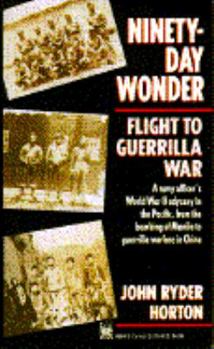Ninety-Day Wonder: Flight to Guerrilla War
A navy officer describes his tenure in China, discussing his role as commander of a guerilla training camp for Chinese soldiers and offering eyewitness accounts of China during World War II. Original. This description may be from another edition of this product.
Format:Mass Market Paperback
Language:English
ISBN:0804105642
ISBN13:9780804105644
Release Date:January 1994
Publisher:Ballantine Books
Length:262 Pages
Weight:0.31 lbs.
Dimensions:0.8" x 4.2" x 6.9"
Customer Reviews
2 ratings
Ding Hao! ("Very Good!")
Published by Thriftbooks.com User , 21 years ago
This is an interesting eyewitness account of wartime China. This book is well-written and vividly portrays the author's experience with Naval training in Chicago, the Japanese invasion of the Philippines, and ultimately his experience "behind the lines" with the US Navy in China. Horton begins by briefly describing his experience of growing up in the Midwest, then of joining the Navy in 1940. Due to the rapid onset of WWII, the US Navy needed officers ...and fast. Therefore, instead of having all cadets spend 4 years at the Naval Academy, the Navy started a 90-day accelerated officer-training program in Chicago (hence the nickname applied to the graduating Midshipmen). This is a well-written and engaging book, though it is also at times a bit dark and cynical. Horton describes his experiences vividly, but also spends a fair bit of time criticizing his American and Chinese superiors. His main criticism is that his superiors, for various reasons, repeatedly hindered his efforts to attack the Japanese. Although his complaints at times grow tiresome, his enthusiasm, patriotism, and resourcefulness cannot be questioned and his observations of wartime China and of the Chinese are thought-provoking. All in all, I found this book to be very informative, descriptive, and insightful.Incidentally, my father followed in Horton's footsteps a few years later. Also a 90-Day Wonder, he was likewise sent to China and fought behind the lines, training Chinese guerillas with the 3,600-man Naval Group China, known as SACO (the Sino-American Cooperative Organization). My father shared many of Horton's opinions and experiences in this little-known theatre of war, including afterwards a lifelong fascination with China.Other interesting books about this theatre include Mishler's "Sampan Sailor" (an engaging and uplifting, though at times anecdotal account of a sailor's experience in Southeastern China during WWII), and the definitive book, "A Different Kind of War" by Admiral Milton Miles, who led Naval Group China during WWII. Miles' fascinating and exceptionally-written book is out-of-print, unfortunately, but is a "must-read" for anyone interested in wartime China.
Well Told Tale of War Service
Published by Thriftbooks.com User , 22 years ago
Among the more obscure campaigns and operations of the war in China were the seemingly incongruous operations of the US Navy in support of the Chinese Nationalist forces. One may quickly ask what were they doing so far inland from the open seas?Well there were several reasons, one was to set up weather stations so that naval aviators could safely approach the coast and attack Japanese shipping, and American submarines could hide in the mists and rain while surfaced for recharging or lying in wait for the enemy. Another major task was in support of the long range plans for the attack on Japan itself. The coastal zone north of Hong Kong though patrolled by the Japanese was not occupied and was a porous zone of smugglers and travellers back and forth between the two opposing sides. There were plans to land US forces there and build up for a western approach to Japan via Manchuria to squeeze the country against the approaching forces from the Pacific side.The long range plan had to gather what is known as basic intelligence, that is, weather, climate, infrastructure, topography, the social situation, and any other information that could be used in campaign planning but which does not change quickly; the latter is known as Order of Battle and tactical intelligence detailing enemy dispositions and is gleaned from many of the disciplines, IMINT, HUMINT, and SIGINT.Once gathered, basic intelligence remains more or less permanently useful except for the effect of major engineering projects such as highways, dams and reservoirs.At the same time, Naval Group, China, was tasked with training and equipping Chinese tactical units intended for clandestine operations against Japanese internal garrisons and transportation networks. And finally with setting up observation networks to report on coastal shipping so that the submarines could be guided to attack positions. This book covers the author's activities with one of the Naval sponsored guerilla units. Among all the writing on the multifarious naval activities in China, there is very little on the special operations except for a very scarce and long out of print book prepared as an official report in the forties and later privately published. For other naval personal narratives of WW II China, see Wen Bon and Sampan Sailor, also reviewed on this site.





